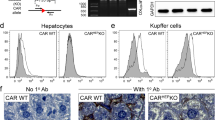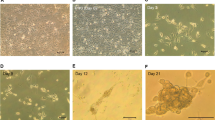Abstract
THE viruses of human hepatitis are elusive, but new tissue culture techniques have resulted in a rapid increase of the number and variety of the so-called hepatitis “candidate viruses”, although conclusive proof of their aetiological association with hepatitis is not available. After the isolation in Arizona of the San Carlos agents1, later identified by neutralization tests as adenovirus type 3, from thirteen of twenty-two Indian children admitted to hospital with infectious hepatitis and from four of thirty-one patients in another outbreak, there has been considerable interest in the possible association of the adenovirus group with hepatitis. Some biological similarities have been found between infectious canine hepatitis virus and certain types of human adenoviruses, and some antigenic relationship to types 2 and 4 (ref. 2). Infectious canine hepatitis (ICH) virus is a DNA virus belonging to the adenovirus group3. Its size of 80 mµ and its 252 capsomeres are identical with that of the adenoviruses. Human infections with ICH virus have been recorded but with no overt signs of hepatitis. Adenovirus type 5 has been isolated from blood clots from twenty-seven of thirty sporadic cases of infectious hepatitis in Arizona4. Adenovirus type 5 was also recovered from all of twelve family contacts of two of the patients, three of whom subsequently developed infectious hepatitis.
This is a preview of subscription content, access via your institution
Access options
Subscribe to this journal
Receive 51 print issues and online access
$199.00 per year
only $3.90 per issue
Buy this article
- Purchase on Springer Link
- Instant access to full article PDF
Prices may be subject to local taxes which are calculated during checkout
Similar content being viewed by others
References
Davis, E. V., Science, 133, 2059 (1961).
Carmichael, L. E., and Barnes, F. D., Proc. Soc. Exp. Biol. and Med., 107, 214 (1961).
Kapsenberg, J. G., Proc. Soc. Exp. Biol.(N.Y.), 101, 611 (1959).
Hartwell, W. V., Love, G. J., and Eidenbock, M. P., Science, 152, 1390 (1966).
Zuckerman, A. J., Tsiquaye, K. N., and Fulton, F., Brit. J. Exp. Path., 48, 20 (1967).
Ehrmann, R. L., and Gey, G. O., J. Nat. Cancer Inst., 16, 1375 (1956).
Huebner, R. J., Row, W. P., Turner, H. C., and Lane, W. C., Proc. U.S. Nat. Acad. Sci., 50, 379 (1963).
MacKay, I. R., and Wood, I. J., in Progress in Liver Diseases (edit. by Popper, H., and Schaffner, F.), 39 (Grune and Stratton, N.Y., 1961).
Eaton, M. D., Murphy, W. D., and Hanford, V. L., J. Exp. Med., 79, 539 (1944).
Bjorneboe, M., and Krag, P., Acta Path. Microbiol. Scand., 24, 352 (1947).
Gajdusek, D. C., Arch. Intern. Med., 101, 9 (1958).
MacKay, I. R., and Larkin, L., Austral. Ann. Med., 7, 251 (1958).
Author information
Authors and Affiliations
Rights and permissions
About this article
Cite this article
ZUCKERMAN, A., ALWEN, J. & FULTON, F. Adenovirus Infection of Human Embryo Liver Cells. Nature 214, 606–608 (1967). https://doi.org/10.1038/214606a0
Received:
Revised:
Issue Date:
DOI: https://doi.org/10.1038/214606a0
This article is cited by
-
Establishment of organ cultures of human embryonic liver for growth of viruses
Archiv f�r die gesamte Virusforschung (1972)
Comments
By submitting a comment you agree to abide by our Terms and Community Guidelines. If you find something abusive or that does not comply with our terms or guidelines please flag it as inappropriate.



